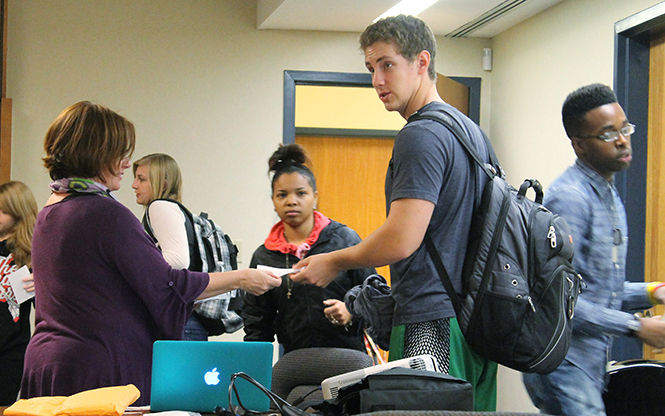Green Dot program to offer gender and communication certificate
Cassandra Pegg-Kirby, assistant director for the Women’s Center, educates students on the Green Dot Program and hands out informational pamphlets. “Doing something and doing nothing are both choices,” she said Thursday, Oct. 29, 2014.
March 9, 2015
The Green Dot program at Kent State will certify students in a Gender and Communication class on Thursday, March 12.
Green Dot certification, an eight-hour training program, is designed to help students learn to recognize potentially dangerous situations and how to intervene without putting themselves at risk.
“The Green Dot program is the official Kent State bystander intervention program,” said Suzy D’Enbeau, assistant professor in the School of Communication Studies, who teaches the certification class. “It’s a bystander intervention program that gives primarily students, but all member of the university community, the tools they need to intervene if they think someone wrong could potentially happen.”
Usually the certification process is a stand-alone workshop that students volunteer to do, D’Enbeau said. Since this will be taking place in the Gender and Communication class, the certification process consists of four days.
There are four classes that build off one another that students are learning during the four-day process, said Jennifer O’Connell, coordinator of the Office of Sexual and Relationship Violence Support. O’Connell will be teaching the students who will be Green Dot certified.
“The first module is really about understanding the Green Dot kind of philosophy or the Green Dot program,” O’Connell said. “It’s kind of figuring out who you are as a person, what you stand for and why this is important to you.”
The second class looks at red dots, which are high-risk situations or behaviors one might notice that seem odd, O’Connell said. The majority of people know what sexual assault is or what partner violence and stalking is, but as a bystander, it may look different.
“There’s obvious things, then there’s subtle things,” O’Connell said. “That little light bulb might come on that says ‘no that does not look quite right,’ and maybe it is nothing, but maybe it is something.”
The third class looks at what may prevent students from intervening in a situation, O’Connell said.
“It looks at what might prevent you from responding and then goes into how you could respond,” O’Connell said. “You have an obstacle, so what are some options to get around that obstacle.”
The fourth class looks at the proactive ways you can intervene, O’Connell said.
“There is a lot of acts of unsafe and even if you just learn to recognize unsafe situations and that is the only thing you take away from Green Dot, it is well worth it,” said Sheila Straw, a junior public health and education major in the College of Public Health with a minor in women’s study.
Contact Jessica Darling at [email protected]












